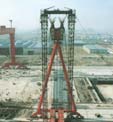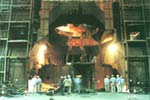|
|
||||||
|
|
||||||
|
||||||
|
Industries Heavy Industry |
Heavy Industry/Crane Control Background Information: HSLT CraneHydraulic Synchronizing Lifting Technique (HSLT) Frame Crane Designed for Oversize ComponentsFrom a report by Tongi University, Shanghai Engineering Technology Research Center of Construction RoboticsIn 2002, Data-Linc wireless Ethernet modems were selected to provide a reliable, cost-effective data communication solution for an oversized component shipbuilding application. Data needed to be transferred between two central monitoring/control stations and the new-concept HSLT (Hydraulic Synchronizing Lifting Technique) frame crane. The greatest challenge was to send and receive data in spite of electric sparking and RF interference. In addition to overcoming the inherent and imposed interference, the installation required error-free continuous operation 24 hours a day for five successive days at a time. (See application note and diagram.) Below is background information on the HSLT technology from a report and photographs provided by Tongi University, Shanghai. Hydraulic Synchronizing Lifting Technique features and benefits
HSLT Technology
The key to the Hydraulic Synchronizing Lifting Technique is a set of hydraulic equipment comprised of a load-supporting system (flexible strands or rigid rods) hydraulic riggers, a sensor measuring system, a computer control system and an electro-hydraulic servo-system. This equipment (integrated by Mechanism Electronics, Hydraulics, Sensor, Computer and Control Theory) automatically executes the various functions and operations, such as lifting or lowering synchronization, uniform load distribution, position-verification, stress-control, anti-error-operation, parameter-display and fault-warning. High profile projects utilize HSLT frame craneThe Hydraulic Synchronizing Lifting Technique frame crane has been used in a number of high profile projects in China: |
||
| A Hydraulic Synchronizing Lifting Technique crane was used in the Shanghai Oriental Pearl Broadcasting and TV Tower project where the steel antenna was lifted in its entirety to a height of 350m on four lifting points by 20 500KN jacks and 120 steel strands. The antenna mast has a height of 118m and weighs 450 tons (April 1994). |  |
|||
 |
In Beijing, the completed steel arch over the main gateway of Beijing Western Railway Station was lifted to a height of 43.5m on eight lifting points by sixteen 2000KN jacks, eight 500KN jacks and 336 steel strands using an HSLT frane crane. The arch is 45m long, 28.5m wide and weighs 1800 tons (December 1994). | |||
| The steel frame of a Shanghai theater was also constructed using an HSLT crane. The entire steel roof structure of Shanghai’s Great Theater was lifted to the height of 26.5m on four lifting points by forty-four 2200KN jacks and 792 steel strands. The structure is 100 meters long, 90 meters wide, and weighs 6075 tons (July 1996). |  |
|||
 |
Two 600 ton gantry cranes of Shanghai Waigaoqiao Shipbuilding Co., Ltd. were both lifted and installed by an HSLT frame crane with the rigid legs and flexible legs providing two bearing points. The topmost level, rail width, and weight of the main girder are respectively 86 m, 185m (155m) and 2900 ton (2200 tons). The rigid leg was used as command lift point, while the flexible leg provided the following lift point and was reinforced by two 2000KN jacks and guy ropes. The main girder was lifted synchronously by twenty 2000KN jacks (In cooperation with Shanghai Port Machine plant in June and November 2001). | ||
 |
An HSLT crane also managed the placement of the steel roof of a four-bay airplane hangar at Capitol Airport and the construction of Shi Tong Kou Power Plant with an installation of six 240m steel funnels. | ||
| The dismantling and installation of Baosteel Group Corporation’s two converters were successfully carried out by a Hydraulic Synchronizing Lifting Technique frame crane. The replacement of the two converters, which weigh 300 tons, involved pre-spreading, incising, synchronizing continuous descent, overturning, synchronizing continuous lifting and joining (In cooperation with Sjamgjao Baosteel Metallurgy Construction Corporation, August, 2000 and March 2001). |  |
|
 The Va Ji Sha Bridge, which spans both the main and the subsidiary sea routs of the Pearl River, belongs to the west circular freeway to the southeast of GuangZhou and has a total length of 1,084m with 360m in the main span and a height of 76m for the main arch. During construction, the two pieces (spanning 180 m each) of the main arch were assembled separately at the two opposite banks, rotated vertically and then horizontally to be combined as a complete arch. The Va Ji Sha Bridge, which spans both the main and the subsidiary sea routs of the Pearl River, belongs to the west circular freeway to the southeast of GuangZhou and has a total length of 1,084m with 360m in the main span and a height of 76m for the main arch. During construction, the two pieces (spanning 180 m each) of the main arch were assembled separately at the two opposite banks, rotated vertically and then horizontally to be combined as a complete arch.  To accomplish the maximum vertical lift load of 30,000KN each at the two sides, 40 jacks (20 at each sided) and 720 steel strands were used. The scale of the rotating system and the difficulty of the task have rarely been seen in the world’s history of bridge construction. Despite these unique challenges, use of the Hydraulic Synchronizing Lifting Technique crane allowed the sea-routes to remain open at all times during the construction project. (In cooperation with the Bridge Engineering Parent Company, Guizhou Province, Oct. 1999) . To accomplish the maximum vertical lift load of 30,000KN each at the two sides, 40 jacks (20 at each sided) and 720 steel strands were used. The scale of the rotating system and the difficulty of the task have rarely been seen in the world’s history of bridge construction. Despite these unique challenges, use of the Hydraulic Synchronizing Lifting Technique crane allowed the sea-routes to remain open at all times during the construction project. (In cooperation with the Bridge Engineering Parent Company, Guizhou Province, Oct. 1999) . |
|||||
ConclusionIn China, the Hydraulic Synchronizing Lifting Technique crane has received formal recognition for scientific and technical progress in the form of prestigious awards from Shanghai Administration, The State Education Committee, Ministry of Education, Ministry of Mechanical Engineering , The Shanghai Administration Office for New High Technical Achievement Projects, as well as others. The Hydraulic Synchronizing Lifting Technique frame crane, which is a part of the National Hi-tech Research and Development Program of China (863 Program) handles oversized components in dismantling, building and construction projects with relative ease. The hi-tech HSLT crane provides numerous features to meet the various functions and challenging operations in this industry of mega-giants. |
|
|
Even in the presence of high EMI and RF interference, Data-Linc wireless Ethernet modems provide a reliable, cost-effective data communication solution for the demands of heavy industry. When information needs to be transferred between a monitoring/control station and the HSLT crane system, Data-Linc's robust technology offers error-free continuous operation despite the challenges imposed by harsh industrial environmnts. For detailed information on how Data-Linc Ethernet radio modems interface with the HSLT frame crane system in a shipbuilding application, please see application note and diagram or contact us via Go to Mateial Handing or Heavy Industry |
| ^ Top of Page ^ | ||
|
|
||
| Products |
Features & Benefits | Focus Item | Product Selection Guides | Catalog | PDF Library | Order Information | |
| Tech Resources |
Engineering Specifications | Articles & Technical Papers | Installation Information | |
| Partners |
GE Fanuc | Omron | Rockwell Automation | Schneider Electric | Siemens | Technology Partners | |
| Industries |
Security | Traffic | and other industry application notes and diagrams | |
| Sales Channels |
Distributors | System Integrators | OEMs | |
| News |
Tradeshows and Events | Press Releases | Newsletters | |
| About Us |
Overview | Jobs/Employment | Office Locations/Contact Information | |
|
|
||
| © 1996-2015 Data-Linc Group. All rights reserved. | ||
| 030905 |





